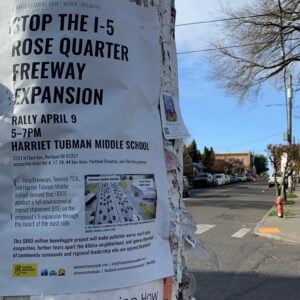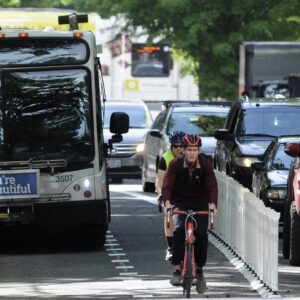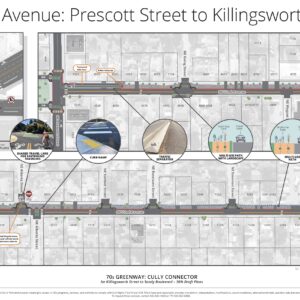If you’re a complete streets advocate, this case in Maryland should definitely be on your radar screen.
According to the Washington Post, a Circuit Court civil jury found the state of Maryland liable in the 2008 death of a woman who was killed while walking on stretch of road that did not have a sidewalk or guard rails.
Here’s more from the Post:
Terrell N. Roberts III, the attorney who represented Smith’s family in the lawsuit, told jurors that the accident was preventable. On the block that Smith and Jones were walking, there is a sidewalk at both ends of the street — but also a gap of about 200 feet where there is no sidewalk or guard rails. The two victims were struck as they walked in that section.
Roberts told jurors that state officials should have provided a sidewalk, guard rails, or a combination to improve safety for pedestrians.
Advocates are often told that installing sidewalks is too expensive; but this case shows that it’s in a state’s best financial and legal interest to make sure roadways are accessible and safe for all users — not just those traveling by car.





It is saddening to hear about the loss of lives here. Perhaps this will be the teaching point that will turn the heads of those who say that complete streets are too expensive.
I’m afraid it may take something like this to fix those storm drain grates I’ve called in (the ones that haven’t been fixed (or fixed correctly)).
It is called personal responsibility. Sidewalks do not prevent deaths and injuries. I seem to remember a crazy nut in a Prius driving on the sidewalk on SE 28th some years back running over several pedestrians.
JPdx – do you have data to back that up? Certainly they don’t prevent *all* deaths. As you illustrated, there’s always at least one instance of someone who is grossly inattentive or aggressive and gets up on the sidewalk, but by and large we don’t have an epidemic of sidewalk-spanning automobiles. The curb tends to discourage it – people are very wary of anything which might damage their vehicle.
Also, there have been many instances in the news in Oregon and other locales where the pedestrian(s) did everything right, yet they were struck and killed anyway – how does “personal responsibility” help them more than a guard rail?
Is “personal responsibility” some kind of code for “wild west’ or “anything goes”?
And does that also hold for, say, car-sized holes in the road? In fact, why don’t we say that the upkeep of the roads is the personal responsibility of all the drivers? They could all come out on the weekends and fill a few potholes.
I am not sure whether this is a case for “complete streets.” When reading the article there is a stunning lack of details regarding the background of why this segment of roadway doesn’t have a sidewalk. For all we know the roadway segment could have been scheduled to be upgraded in a future roadway project and it hadn’t occurred yet. With the information that there was a sidewalk on either side can lead someone to believe that this segment would get a sidewalk in the future. Now, if the state had said “No, we’re not doing it because we don’t want to.” That’s a different story. Unfortunately, from the information we have in the article, we can’t say it one way or another.
I am so tired of seeing deaths as the only way to get officials to change the car-centric engineering of roads.
That said– does this case set any sort of precedent that could be used here in Oregon? For instance, could someone sue a City or the State (whoever is responsible for a certain section of road) for injuries received due to lack of suitable facilities?
I agree with Mike that the article is lacking in information on the roadway.
Here’s an interesting quote from the previous article to the one linked in this post:
“Wesley G. Mitchell, deputy district engineer for the Maryland State Highway Administration, said the lack of a sidewalk and crosswalk in that stretch of Pennsylvania Avenue was a contributing factor in the accident. He said the state is trying to determine possible improvements to the road.”
Another quote from the article, quoting a police officer: “There shouldn’t be any pedestrians walking alongside the road,” said Officer Teresa Watson, who was part of the accident reconstruction team.
Except– there’s nowhere else for them to walk.
http://www.washingtonpost.com/wp-dyn/content/article/2008/08/13/AR2008081303904.html
Looking at the original news report and Google maps, this is a very typical case of a transit stop being poorly placed in an area with a very disconnected and poor pedestrian footpath network. The sidewalks end at the bus stop on one side (also with a break in the guard rail for pedestrian access) and then do not continue in the other direction nor does the stop connect well to the parallel side streets. This stop location away from the signalized junction does not allow transit riders a very safe crossing to the other transit stop – not an uncommon transportation planning / engineering practice in this country.
But back to the state responsibility…it may be a function of their review and permitting of the bus stop (signed and marked) and any engineering direction they gave the transit agency about locating it away from the near by signalized intersection (which has sidewalks and crosswalks, etc.). There may also have been unfunded plans to upgrade what was an identified roadway hazard for pedestrians along this corridor. And there may have been a history of a lack of state police enforcement of speed and other laws along this corridor too.
Looking at Google maps…additionally the historical reconstruction of the State Route 4 looks to have removed a pre-existing local street connection to a signalized junction, and in doing so removed a parallel sidewalk link to the network. For example, WA DOT does provide investment in “Safety Corridors” to help address similar historical deficiencies at local streets that lead to state routes or are affected by traffic diverted from state routes.